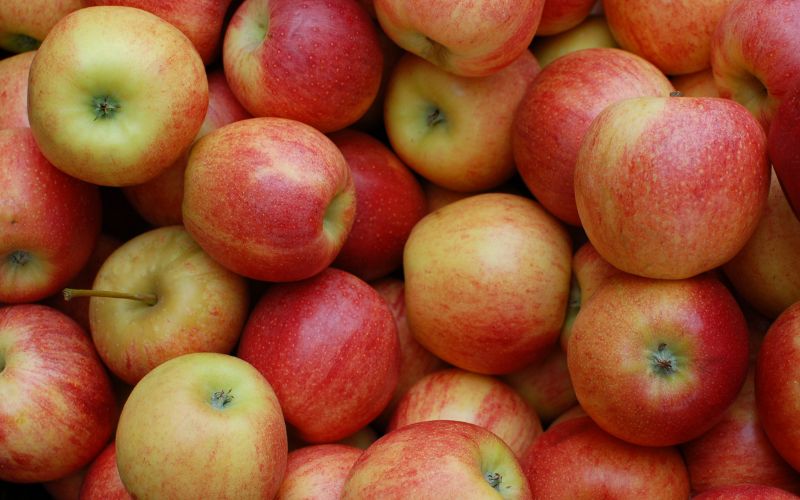What are kiku apples?
Kiku apples are renowned for their exceptional sweetness. When it comes to taste, they rank among the sweetest apples available today.
These apples have a crisp and juicy texture with firm flesh, reminiscent of their Fuji apple parent. They boast a vibrant ruby red color with light stripes, similar to Gala apples.
Kiku® apples, scientifically classified as Malus domestica, originated as a natural mutation found on a branch in a Japanese orchard.
They were then cultivated by an Italian grower in the late 20th century, resulting in the development of this new apple variety.

The name “Kiku®” is a proprietary brand, and only a select group of licensed growers around the world are authorized to commercially cultivate these fruits.
Originally chosen for their captivating deep red color, striped skin, and delightful sweetness, Kiku® apples were introduced as a premium club or brand apple in the early 21st century.
They were sold in limited quantities at higher prices and gained popularity among consumers. Nowadays, Kiku® apples can be found in markets worldwide and are versatile enough to be used in both sweet and savory recipes, providing added texture, flavor, and aroma.
Where did Kiku apples come from?
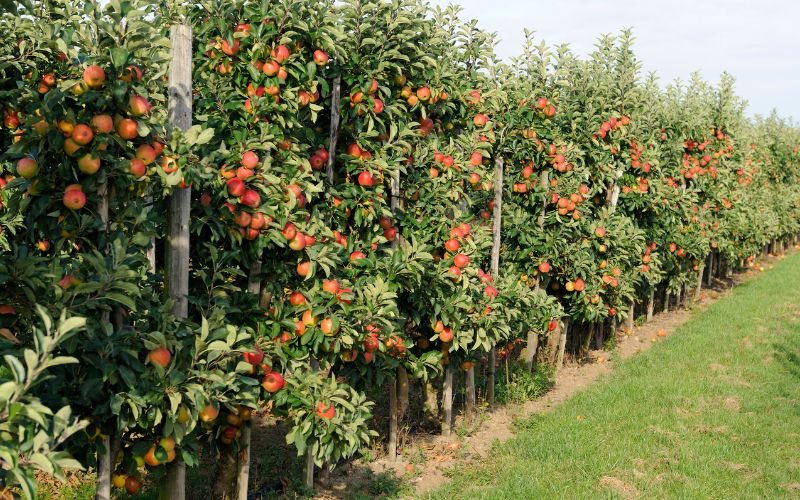
The Kiku Apple was discovered in 1990 by Italian fruit grower Luis Braun during a visit to a Fuji apple orchard in Japan. He noticed a branch on one tree that had apples with a different appearance. Braun decided to propagate these apples in Italy, eventually creating the KIKU® trademark.
The Kiku® apple is a red sport variety of the Fuji apple, native to Japan. After discovering the sport branch, Braun brought it back to his orchard in South Tyrol, Italy, where he spent several years propagating and testing the new variety in collaboration with research institutes.
Finally, the variety was released under the brand name Kiku®, which is a registered trademark of KIKU® Srl-GmbH in Italy. Only select growers who are licensed and approved are allowed to sell the Kiku® apples since their release.
They are primarily cultivated in Italy and were introduced to American markets in 2010. Currently, three companies, namely CMI Orchards in Washington State, Rice Fruit Company in Pennsylvania, and Applewood Orchards in Michigan, are authorized to grow and sell Kiku® apples in the United States.
Additionally, Kiku® apples are also grown in New Zealand and Chile in the southern hemisphere to ensure year-round production. These apples are sold through select grocers and distributors.
Information and characteristics of Kiku apples

Kiku® apples are a medium to large variety, measuring around 10 to 12 centimeters in diameter. They have a round to ovate shape with broad, flat shoulders that taper slightly towards the base.
The stem of the fruit is slender, dark brown, and woody, connecting to the stem cavity, which may sometimes contain a green-brown russet.
The skin is semi-thin, smooth, glossy, and tight, displaying a golden yellow base with large patches of ruby-red blush.
The blush exhibits opaque and translucent red hues, depending on the amount of sunlight the apple receives, and is adorned with dark red striping.
Additionally, the skin features pale lenticels scattered across its surface. Underneath the skin, the flesh of the apple is yellow to ivory in color and has a firm, coarse, and watery texture.
It offers a crisp, crunchy, and succulent consistency. The flesh surrounds a small central core that contains black-brown seeds and occasionally reveals a honey or water core.
When fully ripe, Kiku® apples emit a strong, sweet aroma with floral undertones. This variety is renowned for its intense sweetness.
While commercial apples typically have sugar levels ranging from 12 to 14% Brix, Kiku® apples have a higher range of 14 to 17%, which contributes to their sugary-sweet taste balanced with a hint of acidity.
What do Kiku apples taste like?
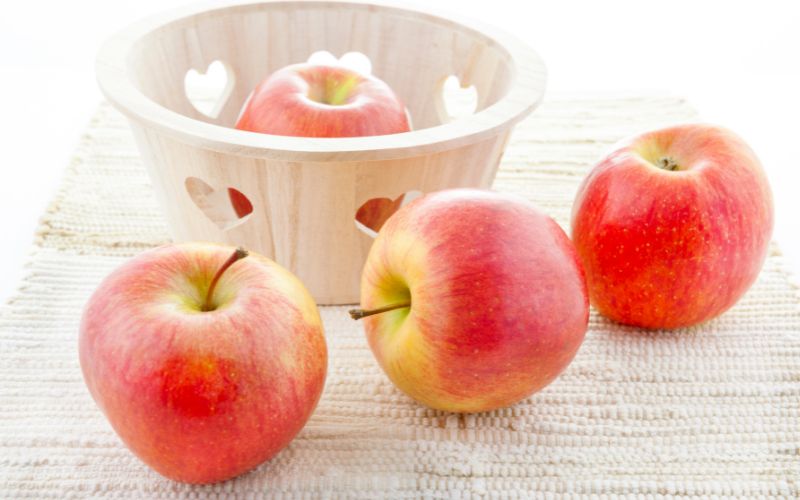
KIKU® brand apples are renowned for their exceptional qualities that make them truly extraordinary. These apples possess an exotic allure with their vibrant striped ruby-red color, which is sure to catch the eye of anyone who sets their gaze upon them.
The moment you sink your teeth into a KIKU® apple, you will be transported to a world of pure sweetness. Every bite is a symphony of flavors, as the super sweet taste dances on your taste buds, leaving you craving for more.
Not only are these apples delectably sweet, but they also offer a delightful crunch that satisfies your desire for a satisfyingly crisp bite.
The firm flesh of KIKU® apples adds to their appeal, ensuring that each mouthful is a textural delight. And let’s not forget about the juiciness – with every juicy bite, you’ll experience a burst of refreshing goodness that quenches your thirst and leaves you feeling invigorated.
It’s no wonder that KIKU® apples are highly sought after by apple enthusiasts worldwide. If you’re eager to experience the pinnacle of apple perfection, head to your nearest retail outlet and indulge in the unparalleled sweetness of KIKU® apples.
Prepare to be captivated by their irresistible charm and fall in love with their divine flavor. Once you’ve tasted a KIKU® apple, it’s safe to say that no other apple will ever compare. So why wait? Treat yourself to the sweetness that awaits you and embark on a flavorful journey like no other.
Are Kiku apples crisp?
KIKU apples are known for their crispness. These delightful apples are not only super sweet in flavor, but they also boast a juicy and crisp texture that is truly satisfying.
When it comes to nature’s marvelous creations, KIKU apples definitely rank high on the list. With their beautiful ruby-red color and striking striped appearance, these apples are a feast for both the eyes and the taste buds.
So, if you’re looking for a delicious and crunchy apple, look no further than the delightful KIKU variety.
How sweet are Kiku apples?
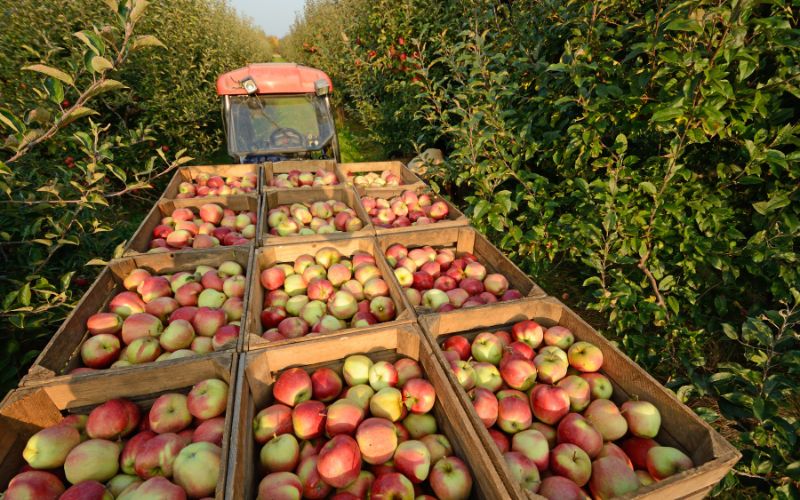
KIKU apples, renowned for their exceptional sweetness, are said to possess the potential to become the sweetest apples one could ever have the pleasure of tasting.
These remarkable apples boast brix levels that typically fall within the impressive range of 16 to 17 percent, and oftentimes even surpass these heights.
Moreover, KIKU apples are celebrated for their unparalleled crispness, which provides a truly satisfying crunch with every bite.
When it comes to juiciness, these apples do not disappoint, as their succulent flesh is sure to leave one’s taste buds thoroughly delighted.
Additionally, KIKU apples showcase a visually captivating appearance with their alluringly striped, ruby-red color, making them a true feast for the eyes.
Finally, the origin story of these apples adds an intriguing element to their allure, further enhancing the overall appeal of this extraordinary fruit.
Are Kiku apples tart?
When it comes to the tart-to-sweet-o-meter, Kiku Apples reign supreme as the sweetest of them! Not only are they incredibly sweet, but they also boast delightful combination ofness and juiciness.
Their firm flesh, which is reminiscent of their Fuji Apple parent, provides a satisfyingly crunchy bite. In terms of appearance, Kiku Apples are a visual treat as well. Their ruby red skin, adorned with light colored stripes, adds a touch of elegance to their overall aesthetic.
What apple is similar to kiku?

Based on the feedback received from testers, it has been observed that the Kiku apple shares certain resemblances with both the Honeycrisp and the Fuji varieties.
When it comes to taste, Kikus are known for being sweet, yet not overly so, striking a perfect balance. Additionally, they possess a subtle tartness that adds a delightful dimension to the overall flavor profile, accompanied by delicate fruity notes reminiscent of grapes.
In terms of texture and juiciness, the Kiku apple can be likened to its close relative, the Fuji apple, ensuring a satisfying bite every time.
What is the difference between Fuji and Kiku apples?
| Comparison | Kiku | Fuji |
|---|---|---|
| Firmness | Both are quite firm | Both are quite firm |
| Aroma | Same strong sweet aroma with floral overtones | Same strong sweet aroma with floral overtones |
| Flesh | Crisp, light yellow, coarse, juicy, and sweet, with faint floral notes | Crisp, light yellow, coarse, juicy, and sweet, with faint floral notes |
| Taste | Kiku tastes slightly better. It is sweeter and has more distinct flavors | – |
| Size | Kiku is sizable and the larger of the two, but regular Fujis can be gigantic | – |
| Shape | Kiku is less ribbed but the two apples have a similar classic shape | – |
| Color | Non-Kiku Fuji’s blush is dustier and more subdued. Kiku’s is a purer red organized into streaks | – |
| Lenticels | – | Fuji has larger lenticels |
| Shine | Kiku is shinier, but that probably just reflects wax applied after washing | – |
| Ripeness | Towards the core of the non-Kiku Fuji, the flesh has some green highlights suggesting less-than-peak ripeness | – |
| Lime hint | – | Fuji has a hint of lime, which in this case subtracts rather than adds to the net result |
Are Kiku apples healthy?
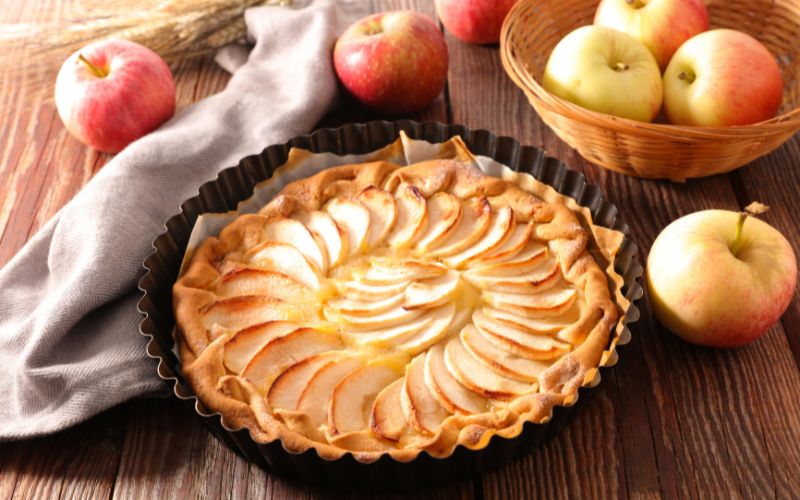
KIKU apples are a healthy and practical choice for both sports activities and leisure breaks. They are also a great alternative to sweets and biscuits when enjoying television in the evening. Mothers are pleased to see their children enjoying a nutritious apple.
Here are the nutritional values for KIKU apples per 100g:
- Energy²: 209 kj / 50 kcal
- Proteins: 0.34g
- Carbohydrates: 10.32g
- Fat: 0.58g
- Water: 84.9g
- Roughage: 2.02g
- Minerals: 0.32g
- Vitamin C: 12mg
A medium-sized apple contains approximately 50 kcal (210 kj). Its high water content of 85% and 12% carbohydrates effectively quenches thirst and provides energy.
As a snack, the apple is always the top choice. The apple’s skin, significantly just below the surface, contains various vitamins such as A, B1, B2, C, and E.
Vitamin C is particularly abundant, meeting almost the daily requirement for humans. The apple also contains elements beneficial for digestion, with pectin helping to reduce cholesterol levels.
The acids present in the apple have anti-bacterial properties. Recent analysis highlights the importance of phenols and carotenoids in preventing cancer and heart and circulatory disorders.
Note: The nutritional values above are based on an average weight per 100g of KIKU apples.
What can I make with a Kiku apple?

The Kiku apple is a versatile fruit that can be enjoyed in various ways. Here are some suggestions on how to make the most of its exceptional taste:
- Snack on it: The Kiku apple’s crisp and juicy interior, snap skin, and sweet flavor make it perfect for snacking. It’s a delightful treat!
- Pair it with cheese or peanut butter: Pair the Kiku apple with cheese slices or peanut butter for an added protein boost. Sharp cheddar is an excellent choice as its sharpness complements the apple’s sweetness.
- Add to fruit salads: Incorporate these beautiful apples into an acidic fruit salad. The acidity will help preserve the white flesh, and you can keep the striped skin intact to showcase its vibrant ruby color.
- Enhance salads: Thinly slice the apples into wedges or rounds and add them to spring salads. They will complement the fresh greens with their bright and sweet flavor.
- Create stunning candied apples: Use Kiku apples to create incredible candied apples. They can be a delicious and visually appealing treat.
- Explore cooking options: Kiku apples have a sweet, balanced taste for fresh and cooked preparations. They can be shredded into slaws, tossed into salads, served with nut butter, layered into grilled cheeses and paninis, or used as a topping over crostini.
- Bake with them: Kiku apples retain their shape when cooked and are prevalent in baking. Try incorporating them into muffins, cakes, pancakes, bread, tarts, pies, crisps, and cakes.
- Get creative with sauces and condiments: Kiku apples add sweet notes to applesauce, jams, and chutneys and can be processed into branded juices, granitas, chips, and vinegar.
- Pair them with other ingredients: Kiku apples pair well with herbs like marjoram, basil, chervil, chives, rosemary, and parsley. They also go well with ingredients like potatoes, celery, limes, garlic, ginger, onions, shallots, almonds, pistachios, pecans, cinnamon, nutmeg, cloves, and allspice.
Remember to store whole, unwashed Kiku apples in an excellent, dry, dark location like a cellar or refrigerator to keep them fresh for up to three months. Enjoy exploring the different ways to enjoy these delicious apples!
Why are Kiku apples so expensive?

When you come across these delicious Kiku brand apples in the store, they tend to have a slightly higher price tag than other apple varieties.
The reason behind this is that the distribution of Kiku apples is quite exclusive, with only a limited number of distributors offering them.
This restricted availability, combined with the ever-growing demand for the unique and delightful flavor of the Kiku variety, plays a significant role in driving up the price of these apples in certain supermarkets.
Purchasing fruits during their specific growing season can help you save money on your produce expenses.
Suppose you are in the United States. In that case, buying these delectable apples straight from the trees during the vibrant autumn season will prove to be a more budget-friendly choice than purchasing them after they have been imported all the way from Chile.
By taking advantage of the seasonality and freshness of Kiku apples, you can enjoy their exceptional taste while being kind to your wallet.

